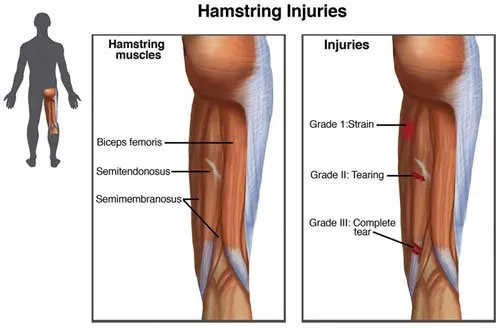
The big group of muscles and tendons in the back of the thigh are commonly called the hamstrings. Injuries in this powerful muscle group are common, especially in athletes. Hamstring injuries happen to all types of athletes, from Olympic sprinters to slow-pitch softball players. Though these injuries can be very painful, they will usually heal on their own. But for an injured hamstring to return to full function, it needs special attention and a specially designed rehabilitation program.
This guide will help you understand:The hamstrings make up the bulk in back of the thigh. They are formed by three muscles and their tendons. The hamstrings connect to the ischial tuberosity, the small bony projection on the bottom of the pelvis, just below the buttocks. (There is one ischial tuberosity on the left and one on the right.) The hamstring muscles run down the back of the thigh. Their tendons cross the knee joint and connect on each side of the shinbone (tibia).
The hamstrings function by pulling the leg backward and by propelling the body forward while walking or running. This is called hip extension. The hamstrings also bend the knees, a motion called knee flexion.
Most hamstring injuries occur in the musculotendinous complex. This is the area where the muscles and tendons join. (Tendons are bands of tissue that connect muscles to bones.) The hamstring has a large musculotendinous complex, which partly explains why hamstring injuries are so common.
Hamstring injuries usually occur during heavy exercise. In especially bad cases, an athlete may suddenly hear a pop and fall to the ground. The athlete may be able to walk with only mild pain even in a severe injury. But taking part in strenuous exercise will be impossible, and the pain will continue.
In less severe cases, athletes notice a tight feeling or a pulling in their hamstring that slows them down. This type of hamstring injury often turns into a long-lasting problem.
The hamstring may be pulled, partially torn, or completely torn. The injury can happen at the musculotendinous junction (mentioned earlier), within the muscle, or where the tendon connects on the ischial tuberosity (avulsion). In the rare case of a complete tear, the pain is excruciating. The torn tissues may form a hard bunch in the back of the thigh when the leg is bent. The skin may also bruise, turning purple from bleeding under the skin. This is not necessarily dangerous but can look somewhat alarming.
When you visit Revital Health Physio & Massage, our physiotherapist will take a detailed medical history that includes questions about your exercise schedule, your activities, and the way you warm up. You will also need to describe your symptoms.
Our physiotherapist will examine the back of your thigh. The physical exam will involve flexing and extending your leg. The probing and the movement may hurt, but it is important to identify exactly where and when you feel pain
Copyright © Sonic Rehab. Designed By Digisnare Technologies.